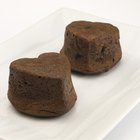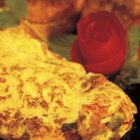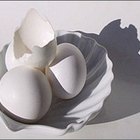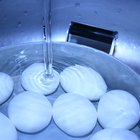
Omelettes are one of those deceptively simple dishes that can be either a quick family meal or an elegant brunch for company, whichever you need at the moment. The best omelets are light, delicate and fluffy, with just a hint of gold from the pan's heat. That takes practice, skill, and a degree of concentration that isn't always easy to muster with kids around. When doing it the traditional way isn't an option, you can always cheat by adding baking powder or baking soda.
Omelette 101
Stripped down to the basics, only the cooking method separates an omelet from scrambled eggs. Scrambled eggs are stirred to create large, soft curds of egg as they cook. Omelet set into a single round, though they can be shaken or gently shifted with a spatula to keep the eggs from sticking or burning. Their light texture comes from a relatively hot pan, which turns the egg whites' water content into steam. The heat also firms up the proteins in the eggs, which trap the steam in small pockets and create the omelet's light and fluffy texture. It's simple enough in theory, though getting the temperature just right takes practice.
Baking Soda and Powder
Like the omelet's natural steam, baking soda and baking powder can also create air pockets in the egg. Baking soda is alkaline, and eggs -- like most foods -- are mildly acidic. A small amount of baking soda can react to the acidity in the eggs, producing bubbles of carbon dioxide that lighten the omelet. Unfortunately it's a very small amount, and difficult to judge. If you use too little the omelet won't fluff, and if you use too much your eggs will taste of soda. Baking powder is easier, because you can use more and it doesn't rely on the eggs' acidity.
Using Soda and Powder
There's enough natural acidity in a three-egg omelet to react with approximately one-eighth teaspoon of baking soda, which most recipes call a "pinch." That's hard to measure accurately, so some recipes call for a few drops of lemon juice to neutralize any excess baking soda. Baking powder can be simpler to work with, because you use more of it and larger amounts are easier to measure. A half-teaspoon of baking powder will lighten three to six eggs when they're cooked as omelets.
Other Options
You can make light and fluffy omelets using other techniques, as well. For example, you can generate extra steam in your omelets -- and therefore, extra rise -- by adding one or two teaspoons of water or milk to the beaten eggs. If you have time, you can also separate the egg whites and beat them to soft peaks, then fold them into the yolks. That's called a "souffle" omelet, and it will puff up to a startling degree when you cook it under a cover. Covering even a standard omelet for one minute will trap extra heat and help it puff.
Related Articles

What Is a Souffle Dish?

Does Adding an Extra Egg to Brownie Mix ...

How to Make Omelets With Baking Powder

How to Thicken a Lemon Filling in Baking
How to Make Eggs Over Easy

A Substitute for Cream of Tartar in a ...
How to Make an Overeasy Egg

How to Freeze Egg Whites
Baking Soda or Baking Powder to Make a ...

Does Lemon Juice Help Keep Raw Eggs ...

How Are Egg Sizes Determined?

How to Overcook Hard Boiled Eggs

Can You Make Dumplings With Corn Starch?

How to Cook a Raw Egg in Instant Ramen

What Is the Difference Between a Fried ...

How to Cook Eggs Sunny Side Up Without ...

How to Cook an Egg White Omelet in the ...

Whole Eggs Vs. Egg Yolks for Sweet Bread

Can I Rebake a Souffle?
How to Make Bakery-Style Whipped Icing
References
- Professional Cooking; Wayne Gisslen
- New York Times: Jacques Pepin -- How to Make an Omelet
- American Egg Board: Omelet
Writer Bio
Fred Decker is a trained chef and certified food-safety trainer. Decker wrote for the Saint John, New Brunswick Telegraph-Journal, and has been published in Canada's Hospitality and Foodservice magazine. He's held positions selling computers, insurance and mutual funds, and was educated at Memorial University of Newfoundland and the Northern Alberta Institute of Technology.
Photo Credits
Thinkstock/Comstock/Getty Images